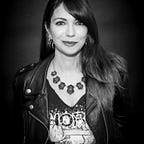Invisible Translation Prototype
I made a covert translation system that wouldn’t freak my mom out.
For the next step in the 5-in-5’s, we had to iterate on one prototype idea. I chose to further investigate the translation glasses for my mom. Speaking and understanding English has always been a hardship for her, so I wanted to design this next iteration with her in mind.
My mom is an adorable tiny lady from Camagüey, Cuba. She keeps an immaculately clean house, reads one Spanish YA book about wizards a week, plays Candy Crush while the Spanish soap opera du jour plays in the background, writes letters by hand in cursive, is a total beast with a machete, and — as I just recently found out this past Christmas — carries a flask of whiskey on her at all times. She takes time putting her outfits together and accessorizes well.
For this iteration, rather than have one object with hidden technology, I split it into two; an earpiece for audio translation and a camera piece to capture signage and text.
My mother isn’t boisterous; she likes to keep a low profile. So these pieces had to offer a level of discretion so that she wouldn’t feel like she was drawing unneccesary attention to herself. I chose to explore jewelry as she likes accesorizing; I figured hiding the technology in jewelry would help her feel at ease about wearing an assistive device.
As shown in the sketches above, I had thought about a modular rectangular piece that you could slide in and out of different pieces of jewelry, but decided it would be too difficult to provide a physical proof-of-concept due to lack of supplies and access to machining equipment. I was kicking myself for not ordering that 3D printer/laser cutter combo during the sad quarantine times of 2020. I thought about modularity in different ways; you have an intrinsic piece that you are able to take apart without losing functionality to suit the level of modesty that she would want.
Earpiece Earring Construction
Inspired by a Wired article, I thought about constructing a translational earpiece that is camoflaged as an earring. In my design process, I start with some intitial sketches just to get the ideas down on paper, but I really start iterating when I have tangible parts in front of me that I can bodystorm with. I took my box of jewelry findings and picked out materials I thought would be useful. I purchased 3 pairs of earbuds from the dollar store to cannibalize.
After researching wireless headphone anatomy, I realized most of them activate via an accelerometer. So with these, they would be off when hanging down, but activated when lifted and inserted into the ear. The idea in the initial sketch was to connect the earbud directly to the chain as once the bud was in the ear, the chain would still keep the appearance of an earring. However, that would limit its modularity. So I decided to glue a clip-on earring armature to the earbud so that it could be easily be removed from the dangling chain, and even worn as an earring itself. The toggle serves as both a decorative and functional elements; although the armature fit through the joining loops, the smaller loop size would not allow for a quick detatch/reattach.
After building the initial prototype I tried it on and it did its job, but I found the chain to be a bit too long, so I reduced the chain length by half for the final product. I painted the earbuds with heavy body silver acrylic to maintain a cohesive look.
Camera Brooch
The second piece of this set is the camera brooch. The camera helps in scanning letters on documents and signage; the translation is then delivered through the earpiece. In the sketch two sections above, I initially thought of having a rectangular module that consisted of a camera, microprocessor and microphone, but ended up building it as an intrinsic brooch. I personally think electrical boards are beautiful so rather than hide the electrical panel, I wanted it to be visible as it resembles jade or malachite. I am very precious about my father’s electrical boards, as they are part of the few things I have left of him, so I was worried about having to cut it. Luckily, it fit almost perfectly and attached it to the pendant armature with joining loops, which give the illusion of wires. Having an electrical board as a decorative element creates a “double take” moment; you see it and think, “ooh, it’s pretty,” but on closer inspection, you ask, “wait, is that an electrical board?” I finished it with a piece from the toggle set, which functions as a tactile directional element (the part that sticks out helps you determine that it’s facing in the right direction) and used a clip, rather than a pin, to make it easier to attach or detatch.
Ultimately, it was deemed a good next step and generated questions about visibile and invisible design, and whether jewelry is the best vehicle for this device. For the next iteration, I decided to investigate possibilities for further modularity and review the pros and cons of visible vs. invisible design.
